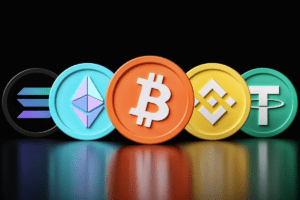Zrozumienie Solany
To grasp the concept of Solana, it is essential to first introduce what Solana is and understand the basics of blockchain technology.
Wprowadzenie do Solana
Solana to wysokowydajny blockchain platforma designed to address the scalability challenges faced by existing blockchain networks. It aims to provide a fast, secure, and decentralized infrastructure for the development of decentralized applications (dApps) and the execution of smart contracts.
Solana differentiates itself by utilizing a unique combination of technologies and architectural design principles to achieve unprecedented scalability without compromising on decentralization. Its innovative approach has garnered significant attention within the blockchain industry.
To delve deeper into the intricacies of Solana, it is important to have a fundamental understanding of blockchain technology.
Podstawy technologii blockchain
Blockchain technology is a decentralized and distributed ledger system that enables the secure and transparent recording of transactions across multiple computers or nodes. It serves as the underlying technology for various cryptocurrencies and platforms, including Solana.
At its core, a blockchain consists of a chain of blocks, where each block contains a list of verified transactions. These transactions are grouped together and cryptographically linked to the previous block, forming a chain of blocks. This immutability ensures the integrity and security of the data stored on the blockchain.
Key characteristics of blockchain technology include decentralization, transparency, immutability, and security. By decentralizing control and relying on consensus mechanisms, such as proof of work (PoW) or proof of stake (PoS), blockchain networks eliminate the need for intermediaries and provide a trustless environment for transactions.
Solana leverages the power of blockchain technology while introducing innovative approaches to scalability. Understanding these concepts will lay the groundwork for exploring Solana’s unique solutions to the scalability challenge. For more information on Solana’s tokenomics, ecosystem, and other aspects, visit our article on Solana.
The Scalability Challenge
In the world of blockchain technology, scalability is a crucial factor for the success and widespread adoption of any blockchain platform. Scalability refers to the ability of a blockchain network to handle a large number of transactions efficiently and in a timely manner. Solana, a high-performance blockchain platform, aims to address the scalability challenge that many existing blockchains face.
The Importance of Scalability in Blockchain
Scalability plays a vital role in the overall functionality and usability of a blockchain network. As the number of users and transactions on a blockchain increases, it becomes essential for the network to handle the load without compromising its performance. Without scalability, blockchains may experience bottlenecks, slower transaction speeds, and higher transaction costs, hindering their ability to be used in real-world applications.
Scalability is particularly crucial in industries that require high transaction volumes, such as finance, supply chain management, and decentralized applications (dApps). By providing a scalable solution, blockchains can unlock the potential for widespread adoption and drive innovation in various sectors.
Common Scalability Issues in Existing Blockchains
Many existing blockchains face challenges when it comes to scalability. Some of the common scalability issues include:
-
Limited Transaction Speeds: Traditional blockchains like Bitcoin oraz Ethereum have limited transaction speeds due to their consensus mechanisms and block size limitations. This can result in slower confirmation times and congestion during peak usage periods.
-
High Transaction Costs: As the demand for transactions increases, so does the cost of processing those transactions. In networks with limited scalability, users may have to pay high fees to have their transactions processed quickly.
-
Low Throughput: Throughput refers to the number of transactions a blockchain can process per second. Many blockchains struggle with low throughput, which can cause delays in transaction confirmations and limit their ability to handle a large volume of transactions simultaneously.
-
Scalability Trade-offs: Some blockchains attempt to improve scalability by sacrificing decentralization or security. These trade-offs can compromise the integrity and trustworthiness of the network.
Solana addresses these scalability challenges by implementing innovative solutions and adopting a unique approach to building a high-performance blockchain platform. By leveraging its architecture and key features, Solana aims to provide fast transaction speeds, low transaction costs, and high throughput. In the next section, we will explore the scalability solutions offered by Solana in more detail.
Solana’s Scalability Solutions
As blockchain technology continues to gain momentum, scalability has become a critical factor in its widespread adoption. Solana, a high-performance blockchain platform, offers unique solutions to address the scalability challenges faced by existing blockchains. Let’s explore Solana’s approach to scalability and the key features that enable it.
Solana’s Unique Approach to Scalability
Solana takes a revolutionary approach to scalability by combining several innovative techniques. One of its key differentiators is the introduction of a breakthrough consensus algorithm called Proof of History (PoH). PoH provides a historical record of all events on the Solana network, enabling efficient and secure ordering of transactions. This eliminates the need for resource-intensive consensus mechanisms, such as Proof of Work (PoW) or Proof of Stake (PoS). By leveraging PoH, Solana achieves unprecedented speeds and scalability without compromising security.
Another critical aspect of Solana’s scalability approach is its use of a unique mechanism called Tower BFT (Byzantine Fault Tolerance). Tower BFT improves the network’s fault tolerance by leveraging cryptographic techniques to validate and confirm transactions. This consensus mechanism allows Solana to achieve fast finality, ensuring that confirmed transactions are irreversible and secure.
Key Features that Enable Scalability
Solana incorporates several key features that contribute to its impressive scalability capabilities:
-
Przetwarzanie równoległe: Solana utilizes a technique known as parallel processing, which allows multiple transactions to be processed simultaneously. By breaking down tasks into smaller units and executing them in parallel, Solana significantly increases the throughput of the network.
-
Globally Shared State: Solana maintains a single, globally shared state across its network. This shared state ensures that all nodes have access to the same information, eliminating the need for complex data synchronization protocols. As a result, Solana achieves high consistency and reduces latency, enabling faster transaction confirmations.
-
Optimized Data Structure: Solana employs a unique data structure called the Tower Ledger. This optimized data structure facilitates efficient storage and retrieval of transaction data, further enhancing the network’s performance and scalability.
-
Proof of Replication: Solana incorporates a mechanism called Proof of Replication (PoRep) to ensure data integrity. PoRep verifies that each node in the network possesses a unique copy of the blockchain data. This redundancy ensures the availability and reliability of data, contributing to Solana’s overall scalability and fault tolerance.
By combining these features, Solana has emerged as a highly scalable blockchain platform capable of handling thousands of transactions per second. Its performance rivals that of traditional financial systems, making it a promising solution for various applications and industries.
As the demand for scalable blockchain solutions continues to grow, Solana’s innovative approach and key features position it as a frontrunner in the industry. To learn more about Solana’s tokenomics, ecosystem, and future plans, check out our article on Solana tokenomics, ekosystem solanaoraz mapa drogowa solana.
The Solana Architecture
To fully understand Solana’s scalability, it’s important to delve into its architecture and the underlying technologies that enable its high-performance capabilities. The Solana architecture is built upon the Solana protocol and utilizes a unique consensus algorithm.
The Role of the Solana Protocol
At the heart of Solana’s architecture is the Solana protocol. The protocol serves as the foundation for the Solana blockchain network, providing the necessary rules and guidelines for its operation. It establishes the framework for how transactions are processed, validated, and recorded on the blockchain.
The Solana protocol incorporates various innovative technologies and features to achieve its scalability objectives. These include a combination of Proof of History (PoH), Proof of Stake (PoS), and other consensus mechanisms. By leveraging these technologies, Solana is able to achieve high throughput and fast transaction speeds, revolutionizing the scalability of blockchain networks.
To gain more insights into the Solana protocol and its unique features, you can refer to the Biała księga Solana.
The Solana Consensus Algorithm
The Solana consensus algorithm, known as Tower BFT (Byzantine Fault Tolerance), plays a vital role in ensuring the security and consensus of the Solana network. Tower BFT is a variation of the traditional Practical Byzantine Fault Tolerance (PBFT) algorithm, tailored specifically to meet the scalability requirements of Solana.
Tower BFT utilizes a combination of PoS and PoH to achieve consensus. PoH provides a chronological order of events, allowing validators to agree on the exact order of transactions. Validators in the Solana network participate in the consensus process by staking their SOL tokens and contributing computational resources to validate transactions and secure the network.
With its unique consensus algorithm, Solana achieves fast finality and low-latency confirmation of transactions, enabling high throughput and scalability. The network is capable of handling thousands of transactions per second, making it well-suited for a wide range of applications and use cases.
By understanding the role of the Solana protocol and the Solana consensus algorithm, it becomes clear how Solana has overcome the scalability challenges faced by many other blockchain networks. Its innovative architecture and technology stack enable fast transaction speeds, low transaction costs, and high throughput, making it a promising solution for the future of blockchain technology.
In the next section, we will explore the advantages of Solana’s scalability and its implications for the blockchain industry. Stay tuned to learn more about the potential applications and use cases of Solana and its impact on the blockchain ecosystem.
Advantages of Solana’s Scalability
Solana’s innovative approach to scalability in blockchain technology brings several advantages that set it apart from existing solutions. These advantages include fast transaction speeds, low transaction costs, and high throughput.
Duża szybkość transakcji
One of the key advantages of Solana’s scalability is its ability to achieve fast transaction speeds. Solana’s unique architecture and design enable it to process a high volume of transactions in parallel. By utilizing a combination of optimized data structures and advanced algorithms, Solana can handle a large number of transactions simultaneously, resulting in significantly reduced transaction times compared to other blockchains.
The fast transaction speeds offered by Solana make it ideal for applications that require near real-time transaction processing. This opens up possibilities for various use cases, such as high-frequency handel, decentralized finance (DeFi) applications, and decentralized exchanges (DEXs). To learn more about Solana’s impact on the blockchain industry, check out our article on Solana’s impact on the blockchain industry.
Niskie koszty transakcyjne
Another advantage of Solana’s scalability is its ability to maintain low transaction costs. Traditional blockchain networks often face scalability issues that drive up transaction fees due to network congestion. Solana’s architecture and efficient consensus algorithm allow it to process a large number of transactions without the need for high fees.
The low transaction costs associated with Solana make it an attractive option for businesses and developers looking to build decentralized applications (dApps) or launch token offerings. By minimizing transaction costs, Solana enables more affordable and accessible participation in blockchain-based activities.
High Throughput
Solana’s scalability solutions also enable high throughput, meaning it can handle a large number of transactions per second. The high throughput capability of Solana’s network is a result of its parallel processing approach and its ability to validate transactions concurrently. This allows for efficient utilization of network resources and ensures that the network can handle increased demand without sacrificing performance.
The high throughput offered by Solana opens up opportunities for applications that require rapid and continuous transaction processing. Use cases such as gaming, digital identity systems, and supply chain management can benefit from Solana’s ability to handle a high volume of transactions seamlessly.
Solana’s advantages in terms of fast transaction speeds, low transaction costs, and high throughput position it as a promising solution for addressing the scalability challenges faced by existing blockchain networks. These advantages make Solana an attractive option for developers, businesses, and users seeking a high-performance blockchain platform.
Przyszłość Solany
As Solana continues to make waves in the blockchain space with its impressive scalability solutions, the future of this technology holds immense potential. Let’s explore some of the potential applications and use cases of Solana, as well as its impact on the blockchain industry as a whole.
Potencjalne zastosowania i przypadki użycia
Solana’s scalability and high throughput make it well-suited for a wide range of applications across various industries. Here are some potential use cases for Solana:
-
Zdecentralizowane finanse (DeFi): Solana’s fast transaction speeds and low transaction costs make it an ideal platform for DeFi applications such as decentralized exchanges, lending and borrowing platforms, stablecoins, and more. Its scalability ensures that these applications can handle a large volume of transactions without congestion or high fees.
-
Gaming and Non-Fungible Tokens (NFTs): The gaming industry has seen a surge in interest in blockchain technology, and Solana’s scalability can provide a seamless experience for gamers by enabling fast and secure in-game transactions. Additionally, Solana’s high throughput is beneficial for NFT marketplaces, where the ability to handle a large volume of transactions is crucial.
-
Zarządzanie łańcuchem dostaw: Solana’s scalability can enhance supply chain management by ensuring fast and transparent transactions. With Solana, businesses can track and verify the movement of goods across the supply chain in a secure and efficient manner, reducing fraud and improving overall transparency.
-
Decentralized Applications (dApps): Solana’s scalability enables the development of complex and high-performance dApps. From social media platforms to decentralized storage solutions, Solana’s fast transaction speeds and low costs provide a solid foundation for building innovative applications that can handle a large user base.
Solana’s Impact on the Blockchain Industry
Solana’s unique approach to scalability has the potential to revolutionize the blockchain industry in several ways:
-
Ulepszone doświadczenie użytkownika: Solana’s fast transaction speeds and low costs enhance the overall user experience, making blockchain technology more accessible to a broader audience. This can drive mainstream adoption and open up new opportunities for innovation.
-
Increased Efficiency: Solana’s high throughput and scalability reduce the congestion and bottlenecks experienced by existing blockchains. This increased efficiency allows for faster and more cost-effective transactions, benefiting businesses and users alike.
-
Spurring Innovation: Solana’s scalability solutions provide developers with a powerful platform to build new and innovative applications. The ability to handle a large number of transactions in real-time can unlock new possibilities and drive the creation of groundbreaking decentralized solutions.
-
Wzrost ekosystemu: As Solana continues to gain traction, its ecosystem is expanding rapidly. This growth includes partnerships with other blockchain projects, collaborations with industry leaders, and the development of a vibrant community. The expanding ecosystem contributes to the overall strength and sustainability of Solana.
With its impressive scalability and potential applications, Solana is poised to shape the future of the blockchain industry. As developers continue to explore its capabilities and businesses leverage its advantages, Solana has the potential to drive widespread adoption and transform how we interact with decentralized technologies.



